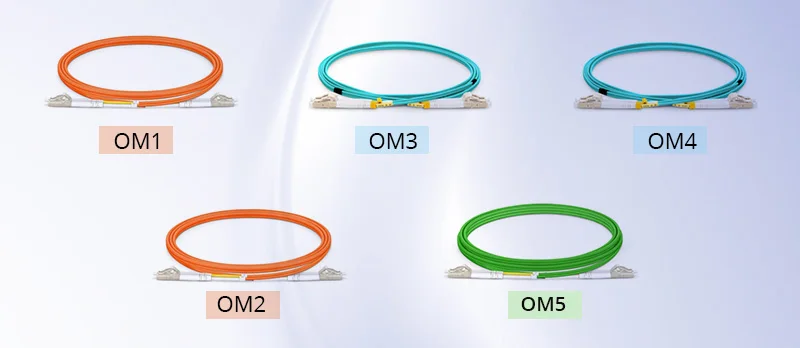

 Knowledge Base +
Knowledge Base +  2024.01.05
2024.01.05OM2 (Optical Multimode 2) is a type of multimode optical fiber commonly used for short-distance communications within a data center or campus network. OM2 fiber is specified by the ISO/IEC and TIA/EIA standards to support Gigabit Ethernet (1 Gbps) and 10 Gigabit Ethernet (10 Gbps) applications. The maximum reach of OM2 fiber for 10G applications depends on the specific transceivers used and the quality of the fiber installation.
For 10 Gigabit Ethernet over OM2 fiber, the typical reach is up to 82 meters (approximately 269 feet). This reach is based on the standard OM2 fiber characteristics and the use of 850nm wavelength transceivers, which are common for multimode fiber applications.
Keep in mind that factors such as connector quality, installation practices, and the presence of splices or other optical components in the link can influence the actual achievable distance. If longer reach is required, you might consider using a different type of multimode fiber, such as OM3 or OM4, which are designed to support higher data rates over longer distances.
Here is a general guideline for multimode fiber reach at 10G:
OM2: Up to 82 meters
OM3: Up to 300 meters
OM4: Up to 400 meters
If you need to cover longer distances or if you are planning for future network upgrades, it is recommended to choose a higher-grade multimode fiber with better performance characteristics. Additionally, consider the specific requirements of your network and the compatibility of transceivers with the selected fiber type.
What is OM1 OM2 OM3 and OM4 OM5?
OM1 OM2 OM3 OM4 OM5 are the names of Iteration of multimode fiber types. “OM” is the abbreviation for Optical Multimode. The Arabic numerals can be regarded as the order of publishing for different generations of multimode fiber standards. In chronological order, the larger the number, the latest release time. OM1 fiber is primeval while OM5 fiber is the latest version. Let’s dive into OM1 OM2 OM3 OM4 OM5 fiber to better understand each multimode fiber type.

Figure : Five multimode fiber types: OM1 OM2 OM3 OM4 OM5 overview
OM1 Fiber
OM1 fiber usually utilizes an orange jacket color and LED light source for the light source. It is also called 62.5/125μm OM1 as it has a fiber core size of 62.5μm and a cladding diameter of 125μm. Though OM1 cable supports 10Gb Ethernet, it can only reach up to 33m. Typically, OM1 multimode fiber is most used in 100Mbit/s Ethernet applications with a 200MHz-km Overfilled Launch (OFL) bandwidth over 850nm and 500MHz-km bandwidth limitation via 1300nm.
OM2 Fiber
Similarly, OM2 fiber also comes with an orange jacket and LED source. What varies is the fiber core diameter narrow to 50μm. It supports running up to 10 Gbit/s within 82m. However, OM2 multimode fiber is most commonly applied in 1G (1000Mbps) Ethernet. Both wavelengths of 850nm and 1300nm are available for OM2 cable at an OFL bandwidth of 500MHz-km.
OM3 Fiber
Both multimode OM3 and OM4 have aqua color-coded jackets and 50μm core diameter. OM3 fiber is Laser optimized multi-mode fiber (LOMMF), designed for use with 850 nm Effect laser launch bandwidth VCSELs. It enables 40G and even 100G Ethernet applications up to 100m transmission distance and is typically used in 10 Gigabit Ethernet for within 300m short-distance applications. Minimum Modal Bandwidth (MBW) of OM3 cable with VCSEL source has an Effect laser launch bandwidth of 2,000 MHz-km at 850nm wavelength.
OM4 Fiber
OM4 fiber is also Laser optimized for using 850nm VCSEL. It is specified to own a 4,700 MHz-km Effect laser launch bandwidth at 850 nm. Compared to the OM3 fiber cable, the OM4 cable support a longer distance at the same data rate. It reaches up to 400m at 10G and 150m at 40G/100G Ethernet. Multimode OM4 fiber cable is backward compatible with OM3 multimode fiber.
OM5 Fiber
OM5 fiber shares the same core diameter with OM2 OM3 OM4, and its optical source, minimum MBW for 850 nm is identical with OM4 multimode fiber. OM5 cable is compliant with OM4 specification at 850 nm. What differentiates OM5 MMF is that it is designed for Wide Band Multimode Fiber (WB MMF) to include extra bandwidth beyond 850 nm for longer reach using Short wavelength division multiplexing (SWDM), which uses four WDM wavelengths across the 850 nm to 940 nm range (850 nm, 880 nm, 910 nm, and 940 nm) to achieve 4x25GbE. The jacket of OM5 fiber color is lime green officially.
OM1 OM2 OM3 OM4 OM5 Comparison
Now that we have an overview impression about OM1 OM2 OM3 OM4 OM5 multimode fiber. Physically it is easy to identify them, then what is the difference between OM1 OM2 OM3 OM4 OM5 to set each apart from the other functionally? In this part, we will elaborate on the main difference in their functional features in several aspects such as bandwidth, wavelength, maximum speed, and transmission distance, etc.
Subscribe to the newsletter
for all the latest updates.
2-5# Building, Tongfuyu Industrial Zone, Aiqun Road, Shiyan Street, Baoan District, Shenzhen. China
